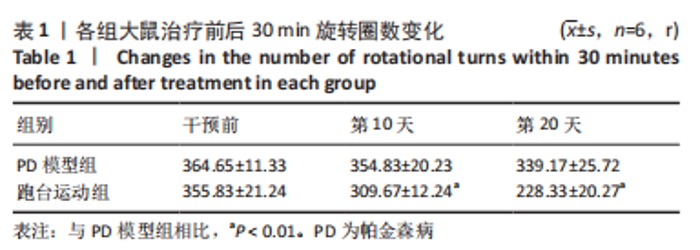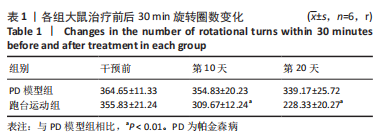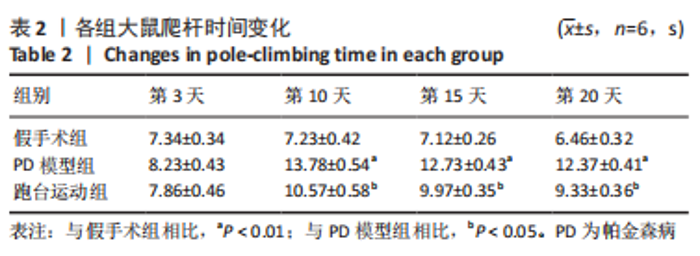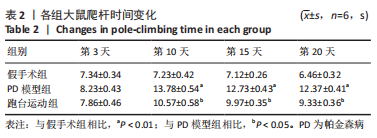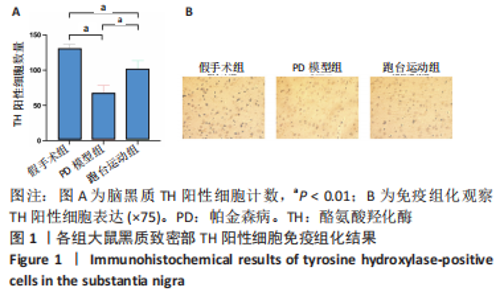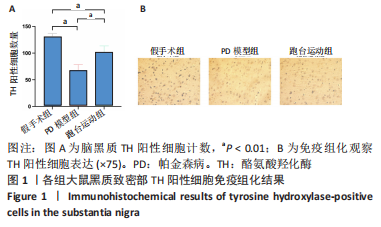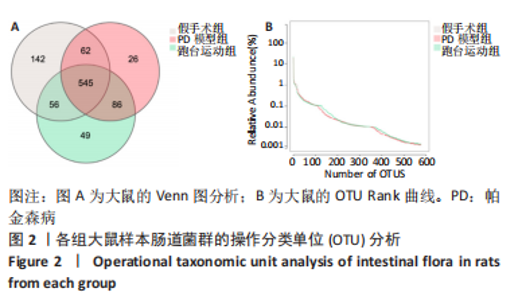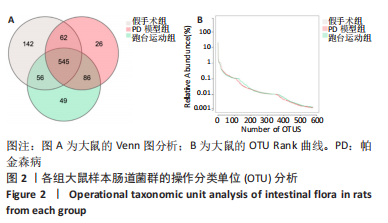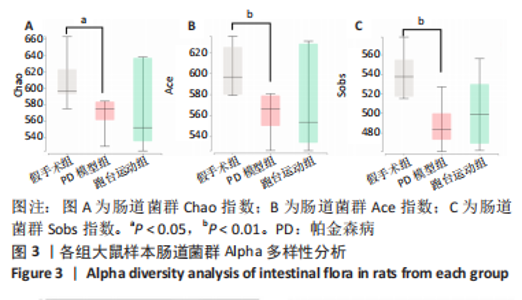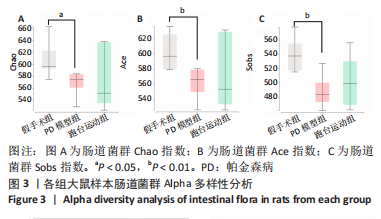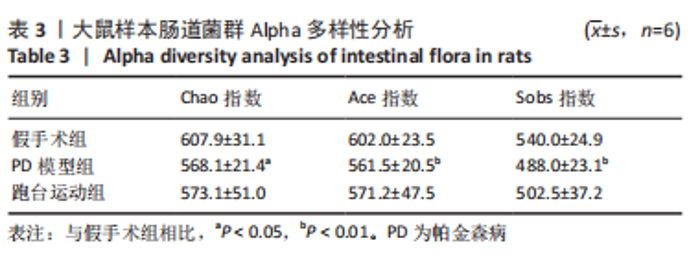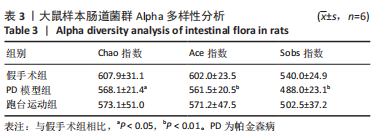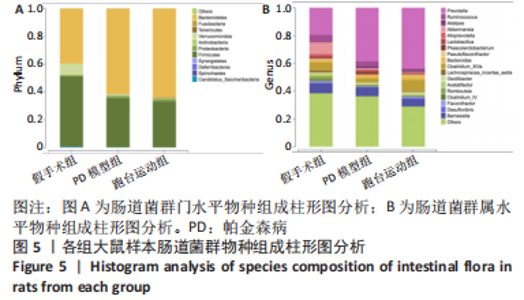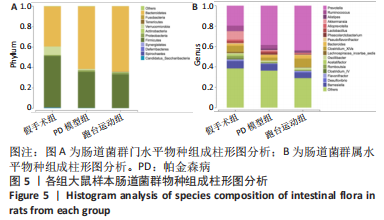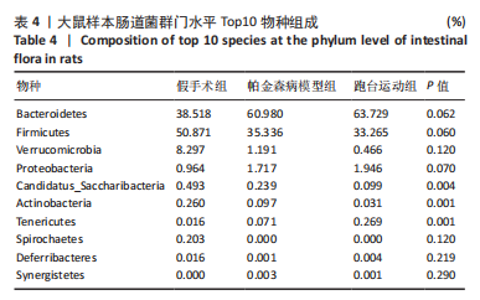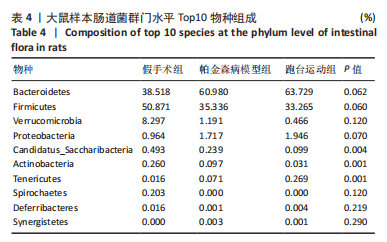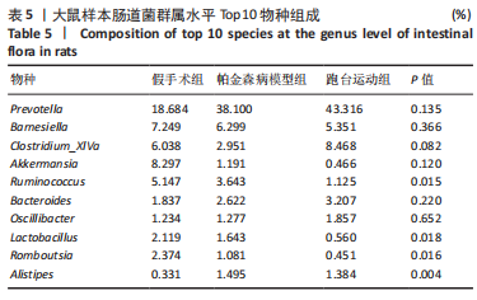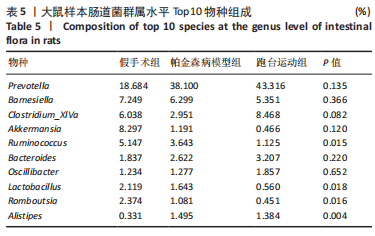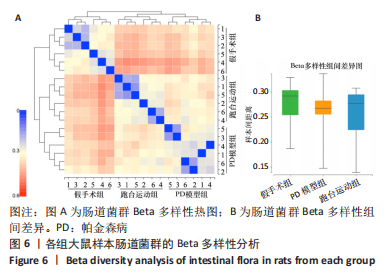Chinese Journal of Tissue Engineering Research ›› 2024, Vol. 28 ›› Issue (14): 2227-2233.doi: 10.12307/2024.223
Previous Articles Next Articles
Effect of treadmill exercise on the structure and diversity of intestinal microflora in rats with Parkinson’s disease
Ma Xinran1, Liu Xinhao1, Li Yujia1, Luo Kailiang2, Ma Shujie3, Hu Jun1, 3
- 1School of Rehabilitation Science, Shanghai University of Traditional Chinese Medicine, Shanghai 201203, China; 2Department of Rehabilitation, The First Affiliated Hospital of Fujian Medical University, Fuzhou 350005, Fujian Province, China; 3The Second Rehabilitation Hospital of Shanghai, Shanghai 200441, China
-
Received:2023-01-19Accepted:2023-03-13Online:2024-05-18Published:2023-07-28 -
Contact:Hu Jun, MD, Chief physician, Associate professor, School of Rehabilitation Science, Shanghai University of Traditional Chinese Medicine, Shanghai 201203, China; The Second Rehabilitation Hospital of Shanghai, Shanghai 200441, China -
About author:Ma Xinran, Master candidate, School of Rehabilitation Science, Shanghai University of Traditional Chinese Medicine, Shanghai 201203, China -
Supported by:National Natural Science Foundation of China (Youth Project), No. 81603713 (to MSJ); Scientific Research Fund Project of Shanghai Municipal Health Commission, No. 202040485 (to HJ); Shanghai Baoshan District Science and Technology Fund Project, No. 20-E-43 (to MSJ)
CLC Number:
Cite this article
Ma Xinran, Liu Xinhao, Li Yujia, Luo Kailiang, Ma Shujie, Hu Jun. Effect of treadmill exercise on the structure and diversity of intestinal microflora in rats with Parkinson’s disease[J]. Chinese Journal of Tissue Engineering Research, 2024, 28(14): 2227-2233.
share this article
Add to citation manager EndNote|Reference Manager|ProCite|BibTeX|RefWorks
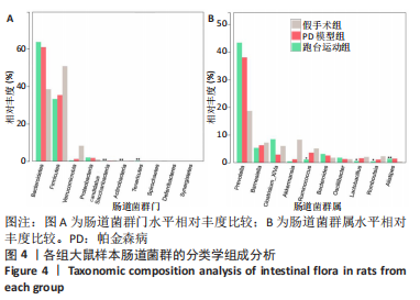
2.7 大鼠样本肠道菌群的分类学组成分析 在门水平,样本菌群中相对丰度最高的前4种菌群分别为Bacteroidetes (拟杆菌门) 、Firmicutes (厚壁菌门) 、Verrucomicrobia (疣微菌门)和Proteobacteria (变形菌门),四者比例之和在各组中均达97%以上。值得关注的是,与假手术照相比,PD模型组中Tenericutes(无壁菌门)的丰度水平由0.016 2%升高为0.071 3%,Actinobacteria(放线菌门)的丰度水平由0.259 6%显著降低至 0.097 1%; Candidatus_Saccharibacteria的丰度水平由0.492 6%显著降低至0.239 3%;经跑台运动干预后,Tenericutes的丰度水平升高至0.268 7%,Actinobacteria和Candidatus_Saccharibacteria的丰度分别降低至0.030 6%和0.099 3%。进一步对肠道菌群进行属水平分析,发现与PD模型组的优势菌群相比,跑台运动组的Barnesiella、Ruminococcus、Lactobacillus、Romboutsia均有所降低,而有益菌Prevotella、Bacteroides、Clostridium_XlVa等呈上升趋势,见图4,5和表4,5。"
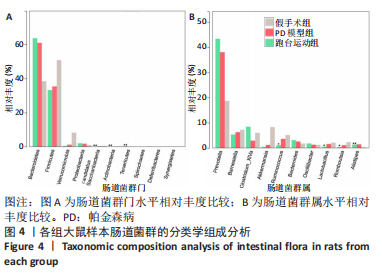
| [1] 梁建庆.帕金森病的发病机制、诊断标准及治疗策略[J].解放军医学杂志, 2018,43(8):631-635. [2] 张贺,姜立刚.帕金森病非运动症状研究现状[J].中国实用神经疾病杂志, 2021,24(1):72-76. [3] 陈芝君,马建,唐娜,等.中国帕金森病疾病负担变化趋势分析及预测[J].中国慢性病预防与控制,2022,30(9):649-654. [4] PD MED Collaborative Group. Long-term effectiveness of dopamine agonists and monoamine oxidase B inhibitors compared with levodopa as initial treatment for Parkinson’s disease (PD MED): a large, open-label, pragmatic randomised trial. Lancet. 2014;384(9949):1196-205. [5] 王宽,詹彦,蒋理,等.丘脑底核脑深部电刺激术治疗伴有异动的帕金森病的疗效分析[J].第三军医大学学报,2020,42(24):2426-2432. [6] Schmidt TSB, Raes J, Bork P. The human gut microbiome: from association to modulation. Cell. 2018;172:1198-1215. [7] 马艺鑫,隋国媛,韩阳.基于阴阳失衡探讨肠道菌群失调与亚健康状态的关系[J].辽宁中医杂志,2020,47(3):104-105. [8] 邹嫄媛, 郑钦日, 徐君铭. 肠道菌群与神经性疾病的研究进展[J]. 临床医学进展,2022,12(1):6. [9] SkjAErbAEk C, Knudsen K, Horsager J, et al. Gastrointestinal Dysfunction in Parkinson’s Disease. J Clin Med. 2021;10(3):493. [10] ZHU Y, YUAN M, LIU Y, et al. Association between inflammatory bowel diseases and Parkinson’s disease: systematic review and meta-analysis. Neural Regen Res. 2022;17(2):344-353. [11] 余锋,贾芳芳,徐帅,等.运动介导肠道微生物-肠-脑轴调控神经功能的机制[J].上海体育学院学报,2021,45(1):66-77. [12] Motiani KK, Collado MC, Eskelinen JJ, et al. Exercise Training Modulates Gut Microbiota Profile and Improves Endotoxemia. Med Sci Sports Exerc. 2020; 52(1):94-104. [13] Crowley EK, Nolan YM, Sullivan AM. Exercise as a therapeutic intervention for motor and non-motor symptoms in Parkinson’s disease: Evidence from rodent models. Prog Neurobiol. 2019;172:2-22. [14] UNGERSTEDT U. 6-Hydroxy-dopamine induced degeneration of central monoamine neurons. Eur J Pharmacol.1968;5(1):107-110. [15] 王利,何建成.复方地黄颗粒对帕金森病大鼠细胞凋亡的干预作用[J].中华中医药杂志,2020,35(8):4122-4125. [16] CARMAN LS, GAGE FH, SHULTS CW. Partial lesion of the substantia nigra: relation between extent of lesion and rotational behavior. Brain Res. 1991;553(2):275-283. [17] Wang W, Lv Z, Gao J, et al. Treadmill exercise alleviates neuronal damage by suppressing NLRP3 inflammasome and microglial activation in the MPTP mouse model of Parkinson’s disease. Brain Res Bull. 2021,174:349-358. [18] Islam MS, Azim F, Saju H, et al. Pesticides and Parkinson’s disease: Current and future perspective. J Chem Neuroanat. 2021;115:101966. [19] Armstrong MJ, Okun MS. Diagnosis and Treatment of Parkinson Disease: A Review. JAMA. 2020,323(6):548-560. [20] 李胜德,王琳,关鸿志,等.脑积水脑室-腹腔分流术后帕金森综合征三例临床分析[J].中国现代神经疾病杂志,2017,17(2):127-132. [21] Turcano P, Mielke MM, Bower JH, et al. Levodopa-induced dyskinesia in Parkinson disease: A population-based cohort study. Neurology. 2018;91(24): e2238-e2243. [22] Prange S, Danaila T, Laurencin C, et al. Age and time course of long-term motor and nonmotor complications in Parkinson disease. Neurology. 2019,92(2): e148-e160. [23] 王孟迪,张秋梅,范蓓,等.基于文献数据库的6-OHDA帕金森病大鼠模型特点分析及在中药研究中的应用[J].中国比较医学杂志,2023,33(1):93-102. [24] Minaei A, Sarookhani MR,Haghdoost YH, et al. Hydrogen sulfide attenuates induction and prevents progress of the 6-hydroxydopamine-induced Parkinsonism in rat through activation of ATP-sensitive potassium channels and suppression of ER stress. Toxicol Appl Pharmacol. 2021;15(423):115558. [25] 华嵘暄,高晗,王博雅,等.菌-肠-脑轴与血脑屏障通透性的相关性研究进展[J].世界华人消化杂志,2022,30(2):100-108. [26] YEMULA N, NJOKU P, TAKYI J. The second brain in Parkinson’s disease: fact or fantasy? Neural Regen Res. 2022;17(8):1737-1738. [27] Houser MC, Tansey MG. The gut-brain axis: is intestinal inflammation a silent driver of Parkinson’s disease pathogenesis? NPJ Parkinsons Dis. 2017;3(1):3. [28] Scheperjans F, Aho V, Pereira PA, et al. Gut microbiota are related to Parkinson’s disease and clinical phenotype. Mov Disord. 2015;30(3):350-358. [29] Hill-Burns EM, Debelius JW, Morton JT, et al.Parkinson’s disease and Parkinson’s disease medications have distinct signatures of the gut microbiome. Mov Disord. 2017;32(5):739-749. [30] 宋刚,廖帅雄.运动与肠道菌群研究综述[J].中国体育科技,2019,55(10):56-61. [31] 廖沁,曾来生,陈杨,等.基于16S rRNA测序分析游泳运动对小鼠肠道菌群的影响[J].江西医药,2022,57(5):437-443. [32] 张博枰,申延琴.肠道菌群与帕金森病的研究进展[J].延安大学学报(医学科学版),2021,19(1):80-86. [33] Sun MF, Zhu YL, Zhou ZL, et al. Neuroprotective effects of fecal microbiota transplantation on MPTP-induced Parkinson’s disease mice: Gut microbiota, glial reaction and TLR4/TNF-α signaling pathway. Brain Behav Immun. 2018;70:48-60. [34] PEREZ-Pardo P, Dodiya HB, Engen PA, et.al. Role of TLR4 in the gut-brain axis in Parkinson’s disease: a translational study from men to mice. Gut. 2019; 68(5):829-843. [35] 刘蓉,栾春光,王德良,等.基于高通量测序分析黄酒对D-半乳糖致衰老小鼠模型肠道微生物菌群的影响[J].食品与发酵工业,2020,46(2):32-39. [36] Strandwitz P, Kim KH, Terekhova D, et al. GABA-modulating bacteria of the human gut microbiota. Nat Microbiol. 2019;4(3):396-403. [37] Otaru N, Ye K, Mujezinovic D, et al. GABA Production by Human Intestinal Bacteroides spp.: Prevalence, Regulation, and Role in Acid Stress Tolerance. Front Microbiol. 2021;12:656895. [38] 李雪,孟庆雄.肠道微生物对寿命的影响及其机制[J].中国生物工程杂志, 2022,42(4):49-57. [39] 卢芳,闫静思,张冶,等.基于16S rRNA基因测序技术研究刺五加对帕金森病模型大鼠肠道菌群结构及多样性的影响[J].药物生物技术,2021,28(6): 551-560. [40] Hayashi A, Nagao-Kitamoto H, Kitamoto S, et al. The Butyrate-Producing Bacterium Clostridium butyricum Suppresses Clostridioides difficile Infection via Neutrophil- and Antimicrobial Cytokine-Dependent but GPR43/109a-Independent Mechanisms. J Immunol. 2021;206(7):1576-1585. [41] GASALY N, Hermoso MA, Gotteland M. Butyrate and the Fine-Tuning of Colonic Homeostasis: Implication for Inflammatory Bowel Diseases. Int J Mol Sci. 2021;22(6):3061. |
| [1] | Chen Mengmeng, Bao Li, Chen Hao, Jia Pu, Feng Fei, Shi Guan, Tang Hai. Biomechanical characteristics of a novel interspinous distraction fusion device BacFuse for the repair of lumbar degenerative disease [J]. Chinese Journal of Tissue Engineering Research, 2024, 28(9): 1325-1329. |
| [2] | Min Meipeng, Wu Jin, URBA RAFI, Zhang Wenjie, Gao Jia, Wang Yunhua, He Bin, Fan Lei. Role and significance of artificial intelligence preoperative planning in total hip arthroplasty [J]. Chinese Journal of Tissue Engineering Research, 2024, 28(9): 1372-1377. |
| [3] | Wang Menghan, Qi Han, Zhang Yuan, Chen Yanzhi. Three kinds of 3D printed models assisted in treatment of Robinson type II B2 clavicle fracture [J]. Chinese Journal of Tissue Engineering Research, 2024, 28(9): 1403-1408. |
| [4] | Feng Tianxiao, Bu Hanmei, Wang Xu, Zhu Liguo, Wei Xu. Interpretation of key points of International Framework for Examination of the Cervical Region for potential of vascular pathologies of the neck prior to Orthopaedic Manual Therapy (OMT) Intervention: International IFOMPT Cervical Framework [J]. Chinese Journal of Tissue Engineering Research, 2024, 28(9): 1420-1425. |
| [5] | Yu Weijie, Liu Aifeng, Chen Jixin, Guo Tianci, Jia Yizhen, Feng Huichuan, Yang Jialin. Advantages and application strategies of machine learning in diagnosis and treatment of lumbar disc herniation [J]. Chinese Journal of Tissue Engineering Research, 2024, 28(9): 1426-1435. |
| [6] | Weng Rui, Lin Dongxin, Guo Haiwei, Zhang Wensheng, Song Yuke, Lin Hongheng, Li Wenchao, Ye Linqiang. Abnormal types of intervertebral disc structure and related mechanical loading with biomechanical factors [J]. Chinese Journal of Tissue Engineering Research, 2024, 28(9): 1436-1442. |
| [7] | Yang Yufang, Yang Zhishan, Duan Mianmian, Liu Yiheng, Tang Zhenglong, Wang Yu. Application and prospects of erythropoietin in bone tissue engineering [J]. Chinese Journal of Tissue Engineering Research, 2024, 28(9): 1443-1449. |
| [8] | Qi Xue, Li Jiahui, Zhu Yuanfeng, Yu Lu, Wang Peng. Abnormal modification of alpha-synuclein and its mechanism in Parkinson’s disease [J]. Chinese Journal of Tissue Engineering Research, 2024, 28(8): 1301-1306. |
| [9] | Yue Yun, Wang Peipei, Yuan Zhaohe, He Shengcun, Jia Xusheng, Liu Qian, Li Zhantao, Fu Huiling, Song Fei, Jia Menghui. Effects of croton cream on JNK/p38 MAPK signaling pathway and neuronal apoptosis in cerebral ischemia-reperfusion injury rats [J]. Chinese Journal of Tissue Engineering Research, 2024, 28(8): 1186-1192. |
| [10] | Zhao Garida, Ren Yizhong, Han Changxu, Kong Lingyue, Jia Yanbo. Mechanism of Mongolian Medicine Erden-uril on osteoarthritis in rats [J]. Chinese Journal of Tissue Engineering Research, 2024, 28(8): 1193-1199. |
| [11] | Liu Xin, Hu Man, Zhao Wenjie, Zhang Yu, Meng Bo, Yang Sheng, Peng Qing, Zhang Liang, Wang Jingcheng. Cadmium promotes senescence of annulus fibrosus cells via activation of PI3K/Akt signaling pathway [J]. Chinese Journal of Tissue Engineering Research, 2024, 28(8): 1217-1222. |
| [12] | Ruan Rong, Lou Xujia, Jin Qiguan, Zhang Libing, Xu Shang, Hu Yulong. Effect of resveratrol on gluconeogenesis in exercise-induced fatigue rats [J]. Chinese Journal of Tissue Engineering Research, 2024, 28(8): 1229-1234. |
| [13] | Zuo Xinwei, Liu Gang, Bai Huizhong, Xu Lin, Zhao Yi, Ren Jingpei, Hu Chuanyu, Mu Xiaohong. Relationship between lumbar spine development and hip development in children with spastic cerebral palsy [J]. Chinese Journal of Tissue Engineering Research, 2024, 28(8): 1247-1252. |
| [14] | Zhang Xihui, Li Zhengrong, Li Shineng, Xing Zengyu, Wang Jiao. Effect of rehabilitation training guided by Pro-kin balance system on proprioception and balance function of the affected knee after anterior cruciate ligament reconstruction [J]. Chinese Journal of Tissue Engineering Research, 2024, 28(8): 1259-1264. |
| [15] | Kong Jianda, Mu Yujing, Zhu Lei, Li Zhilin, Chen Shijuan. Mechanism of satellite cell regulation and its role in ecological niche signaling during skeletal muscle regeneration [J]. Chinese Journal of Tissue Engineering Research, 2024, 28(7): 1105-1111. |
| Viewed | ||||||
|
Full text |
|
|||||
|
Abstract |
|
|||||
